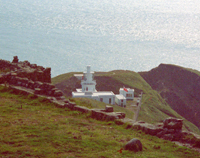The use of Lundy as a launch pad for piracy was on the rise once again during the reign of Elizabeth I, following a rapid increase in the volume of shipping in the Bristol Channel.
In 1564 the Queen wrote to Sir Peter Carew instructing him to organize a foray to the island to rid it of this scourge.
Displaying her customary thrift, she offered only payment-in-kind to reward those taking on the pirates in their lair, and even suggested the Rovers might be bribed to take a hand in rounding themselves up!
Those taking part in the expedition...

Among those pirates known to have used Lundy as a base between 1560 and 1580 are Robert Hickes of Saltash, Captain John Piers of Padstow, and John Challice.
In exasperation the Barnstaple authorities launched an attack on the island in 1587, and succeeded in capturing 'divers rovers and pirates'. Nevertheless pirates continued to use the island, and in 1595 the Queen herself threatened to take control of Lundy if the then owner Sir Barnard Grenville failed to deal with the problem.
Despite this, nothing further was done until 1610, when the Lord Lieutenant of Devon and the Mayor and Corporation of Barnstaple were empowered to send a force against the pirates, including the megalomaniac Captain Salkeld who had seized the island that year and proclaimed himself King of Lundy. Any goods and ships seized by them were to be retained in return for the expenses incurred. Disputes on the division of the hoped-for spoils caused a two-year delay before they were to set sail and chase the pirates off the island to Milford Haven, capturing four prisoners.
Perhaps there was a period of relative peace on the island for a while, as Lundy was thought secure enough in 1618 for Grenville to offer it to Sir Lewis Stukeley as a refuge to isolate him from the odium caused by his arrest and betrayal of Sir Walter Raleigh on return from his ill-fated voyage to Guiana. By this time a social outcast, Stukeley died insane on Lundy in 1620.
This respite did not last long, and in 1625 it was reported that three Turkish pirates had occupied Lundy, capturing its inhabitants, and were threatening to burn Ilfracombe. This attack aroused widespread alarm, and a government inquiry was ordered.
The 1630s seem to have been the heyday of the island's use as a pirate lair. The notorious Captain John Nutt made it one of his headquarters, styling himself Admiral, and leaving his 'Vice Admiral', one John Smith, in charge there.
Sometimes, though, the island was itself the target of sorties by the French and Spanish, as in 1633, when a Spanish man-of-war landed eighty men to sack and plunder it. An account of this raid says 'they burned our farms, took away our young sheep and our daughters, and left us only old ewes and old women'. These present day Lundy sheep look contented enough, having no memory of these turbulent times.
Following this outrage, the government commissioned Captain Sir John Pennington, himself a former pirate and now in command of HMS Vanguard, to end the pirate menace once and for all. His was given absolute powers, but even so two pirates were reported at Lundy the following year, and Algerian rovers were using the island as a base in 1635.
There followed a succession of owners, and no greater tribute can be paid to its continued impregnability than the fact that, when it was held for Charles I during the Civil War, it was surrendered only after hostilities had ended everywhere else in the land, and then only on the written permission of the King who was by now in captivity. Who knows, if Charles had retired to Lundy he might have kept his head!

Again from "The North Devon Story":
There is much more about Thomas Benson here in the Devon Villains section, or you might be interested in an in-depth look at his role in the scandal of the sinking of the Nightingale.

For much of the year, Atlantic low pressure systems bring severe gales that batter the ships plying the Bristol Channel; Lundy is exposed to these fierce winds, and its rocky coast is a potential hazard to these storm weary vessels.
In 1819 work was begun on the building of a lighthouse on the top of Chapel Hill, the highest point on the island. When completed, two lights shone from the tower. The lower was a fixed light, whereas the rotating upper light flashed every 60 seconds. The light revolved so quickly that the upper light also appeared as a fixed light, and from 5 miles away the two lights merged into one.

It was this appearance of being a single fixed light that contributed the sinking of the La Jeune Emma on route to Cherbourg in November 1828. The Lundy lights were mistaken for the fixed light of the lighthouse on the island of Ushant off the coast of France, and she hit the rocks off Lundy with the loss of 13 lives.
The lights were extinguished for the last time in 1897 after complaints from mariners that they were completely invisible in the dense fog that often blankets the top of the island even though visibility is good at sea level, and two new lighthouses were built on the North and South extremities of the island. The original lighthouse remains, standing as a reminder of this folly. Today it is known as the Old Light, and serves as one of the Landmark Trust properties used for visitor accommodation.
Shutter Rock, at the southwest point of the island, was the setting chosen by Charles Kingsley for the wrecking of a Spanish galleon in his historical novel Westward Ho! :
HMS Montagu was wrecked on this very same rock in 1906! The three-year-old battleship had been undertaking trials with a new radio and had moved away from Lundy until contact with the Isles of Scilly was made. On her return in fog she ran aground on Shutter Rock and, despite the slow speed she was travelling, became stuck. All attempts to refloat her failed, and salvage continued until 1922 after which the wreck finally broke up and sank.
